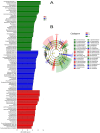Study on intestinal microbial communities of three different cattle populations on Qinghai-Tibet Plateau
- PMID: 39903702
- PMCID: PMC11793767
- DOI: 10.1371/journal.pone.0312314
Study on intestinal microbial communities of three different cattle populations on Qinghai-Tibet Plateau
Abstract
The Tibetan cattle, indispensable·animals on the Qinghai-Tibet Plateau, have become a focal point for the region's economic development. As such, the hybridization of these cattle has been recognized as a pivotal strategy to enhance the local cattle industry. However, research on the gut microbiota of Tibetan hybrid cattle remains scarce. Based on this, we conducted a comparative analysis of the gut microbiota and its functional implications across three distinct cattle populations: two the hybrid cattle populations (Tibetan local cattle × Holstein cattle, TH and Tibetan local cattle × Jersey cattle, TJ) and one the Tibetan locoal cattle population (BL). Bacteroidetes and Firmicutes dominate the gut microbiota across all populations at the phylum level. In addition, the predominant phyla in BL cattle were found to be Cyanobacteria, Verrucomicrobiota, and Actinobacteria, which may be one of the important reasons for the adaptability of Tibetan local cattle to the high-altitude environment of the Qinghai-Tibet Plateau. Further analysis identified specific biomarkers associated with the immune systems of BL cattle, including Bacteroidales_RF16, Coriobacterium, and Muribaculaceae. In contrast, TH cattle are primarily dominated by Oscillospiraceae and Clostridia_UCG_014, and TJ cattle are mainly dominated by Christensenellaceae and Gammaproteobacteria. KEGG enrichment analysis revealed that BL and TH cattle showed significant enrichment in the immune system, energy metabolism, and amino acid metabolism-related pathways compared with TJ cattle. Overall, these results suggest that BL and TH cattle demonstrate enhanced adaptability compared to TJ cattle, and indicate that intestinal microbiota of cattle at different altitudes and breeds have diverse structures and functions. Our study presents a new perspective on the role of the microbiome in the hybridization and enhancement of Tibetan cattle.
Copyright: © 2025 Suolang et al. This is an open access article distributed under the terms of the Creative Commons Attribution License, which permits unrestricted use, distribution, and reproduction in any medium, provided the original author and source are credited.
Conflict of interest statement
The authors declare that the research was conducted in the absence of any commercial or financial relationships that could be construed as a potential conflict of interest.
Figures






References
-
- Yan L, Li Y, Wang L, Zhang XD, Wang JZ, Wu HD, et al.. Grazing significantly increases root shoot ratio but decreases soil organic carbon in Qinghai-Tibetan Plateau grasslands: A hierarchical meta-analysis. Land Degradation & Development. 2020;31(16):2369–78. doi: 10.1002/ldr.3606 - DOI
-
- Qiu YH, Shu PX, Ao H, Zhang YX, Wei Q, Li XW, et al.. The earliest microblade site 6800 years ago reveals broader social dimension than previous thought at the central high altitude Tibetan plateau. Quaternary Science Reviews. 2024;328. doi: 10.1016/j.quascirev.2024.108551 - DOI
MeSH terms
Substances
LinkOut - more resources
Full Text Sources
Research Materials

